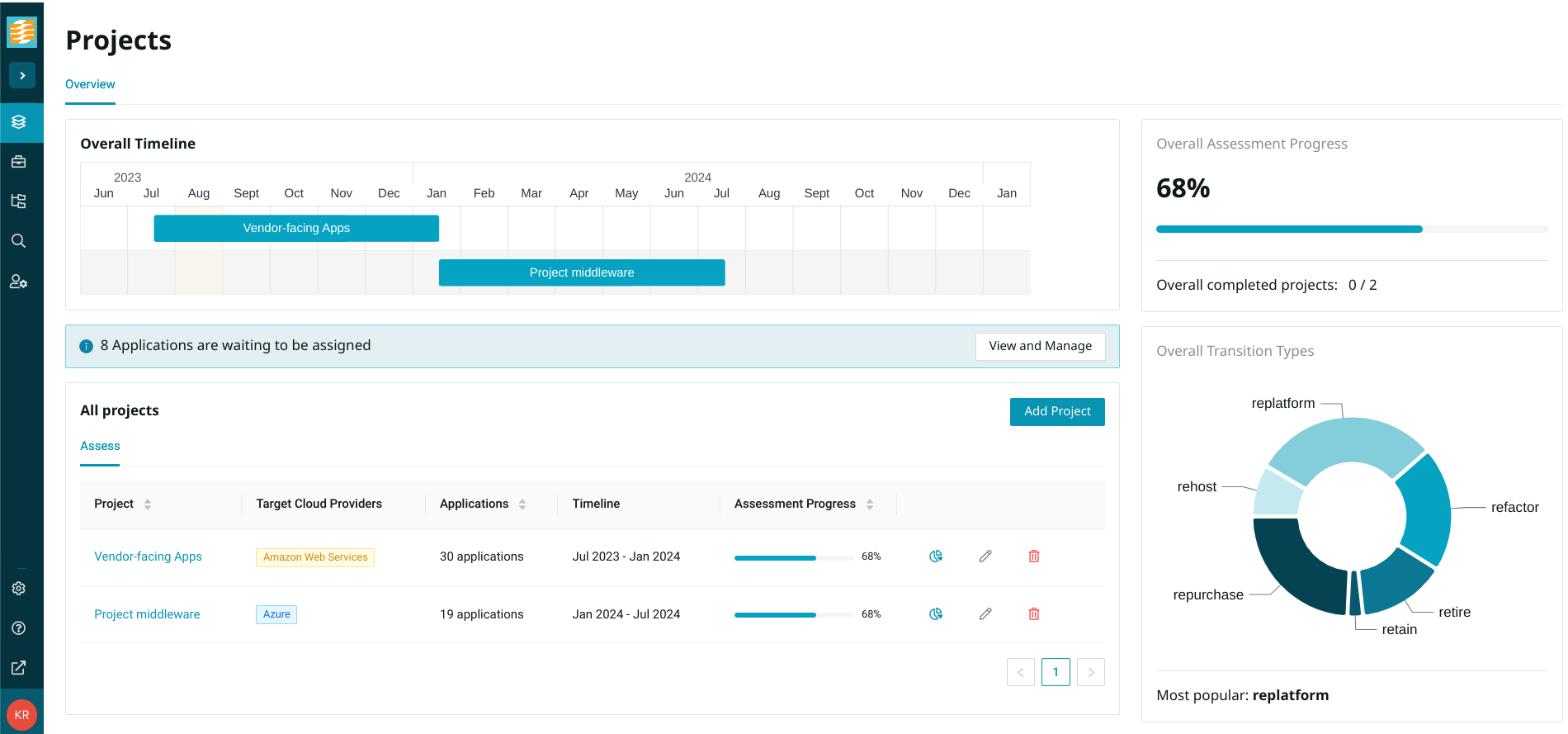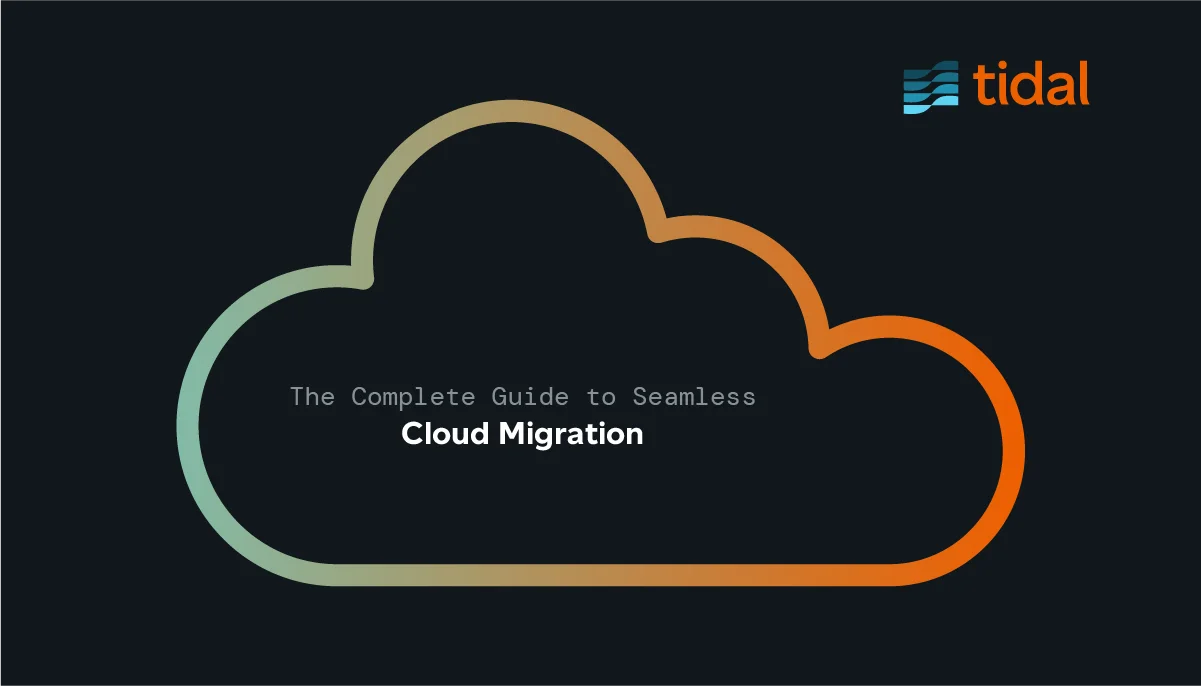Cloud migration is the process of moving an organization’s data, applications, and other elements from one location to another, often from private, on-site servers (also referred to as “on-premises”) to a public cloud provider’s servers or between different clouds. The most significant cloud migration benefits include reducing IT costs, improving performance, and contributing to environmental friendliness through efficient resource utilization and reduced energy consumption.
There are many other advantages, such as increased security, scalability, and more - and customers’ drivers for cloud can differ widely across these items depending on their business objectives and goals:
- Types of Cloud Migration
- Stages of Cloud Migration
- Challenges of Cloud Migration
- Benefits of Cloud Migration
- See Cloud Migration Tools for more
1. Types of Cloud Migration
The most common migration scenarios are mentioned below:
Datacenter Migration
Datacenter migration refers to transferring or relocating data, applications, and digital assets from on-premises data centers to cloud provider servers or between datacenters. The process requires careful planning to minimize disruptions to business operations. Organizations migrate to the cloud to achieve cost savings, improved performance, scalability, and enhanced flexibility in resource allocation. By migrating to the cloud, organizations can reduce the burden of managing physical infrastructures, leverage cloud services’ scalability and agility, and streamline operations for better efficiency and innovation.
Hybrid Cloud Migration
Hybrid cloud migration entails the movement of workloads and data between on-premises and infrastructure and public or private cloud environments, which is helpful when companies only want to move a ‘portion’ of their resources to the cloud. This approach allows organizations to dynamically scale IT resources, seamlessly move workloads, and leverage the benefits of both on-premises and cloud environments. Benefits include reduced costs, minimized risk, and extending existing capabilities to support digital transformation efforts.
Cloud-to-Cloud Migration
Cloud-to-cloud migration is moving data, applications, and other digital assets from one cloud environment to another. Organizations may opt for this migration strategy to better achieve cost efficiency, scalability improvement, and enhanced security. By leveraging multiple cloud providers (often done during mergers or acquisitions) or transitioning to a new provider, organizations can optimize costs, access specialized services, and enhance disaster recovery and data redundancy.
2. Cloud Migration Stages
The most common stages of cloud migration:
Phase 1: Prepare
Evaluate your current IT infrastructure, applications, and data to determine the feasibility, cost, and benefits of migrating to the cloud.
Phase 2: Plan
Rationalize the data collected to create a roadmap for migrations defining goals and objectives, selecting a cloud service provider, outlining steps and a timeline for migration. Enter the 6 R’s of migration:
- Rehost (Lift and Shift)
- Replatform (Lift, Tinker, and Shift)
- Refactor/Re-Architect
- Repurchase
- Retire
- Retain

Phase 3: Migrate
Complete a migration strategy (detailed steps are below) and migrate your data, applications, and other workloads from on-premises systems to the cloud.
Phase 4: Operate and Optimize
Ensure the applications and data continue to operate as expected in the cloud.
Cloud Migration Tools
Discover, assess, and plan your migration with the right tools. Read more about cloud migration tools and the stages of migration.
Migration Strategies
How can these stages be put into action? The migration strategy used at Tidal.Cloud:
1. Business Case
Create your cloud business case. Provide your teams with quick, estimated cost data reconciled with your objectives. Get Tidal Calculator!
2. Cloud Readiness Application Assessment
The Readiness Assessment provides an organization with the clarity of vision and concrete steps required to adopt the cloud.

- Business Case + Review Objectives
- Application and Server Discovery
- Organizational Skills Assessment
- Application Owner Interviews
- Preliminary Application Assessment
- App + DB Target Architecture
- Transition Require
- Transition Wave Planning
- Retire, Repurchase, Rehost
- Refactor, Replatform, Retain
- Policy Automation + Enforcement
- Stabilization + Optimization
Cloud Readiness Assessment
Assessment for organizational readiness, application discovery and application assessments. Available with Tidal Accelerator.
Get Ready
3. Plan Ahead
Make sure your cloud migration plan is bulletproof and data-driven with Tidal. Track your progress, understand your priorities, build a cloud design around your needs, and support your communication plan!
4. Execute
Accelerate your cloud migration and unlock your agile potential via Tidal Accelerator’s collaborative, application-centric approach which allows you to discover, assess, plan, and manage your migration.
5. Optimize
Use intelligent cloud cost optimization to reduce your cloud spend. Identify and dynamically allocate resources for scheduling and map workloads to increase efficiency.
The 6 R’s of migration (as mentioned above):
- Refactor/Re-Architect
- Replatform (Lift, Tinker, and Shift)
- Rehost (Lift and Shift)
- Repurchase
- Retain
- Retire
3. Common Cloud Migration Challenges
Planning
Replicating ‘old ways’ in cloud migration hinders unlocking its benefits. Embrace fresh thinking, leveraging new innovations and automation for faster more efficient processes. Legacy processes yield legacy results.
Cost
Cloud ‘bill shock’ sets in after 3 months when unexpected charges appear. Business cases undercut real-world complexity, lacking realistic budgets, and timelines.
Security and Compliance
Companies often transfer old security ideas to the cloud leaving gaps compared to cloud-native models. Additionally, existing compliance rules don’t fully fit cloud technology, making compliance complex.
Business Downtime
“That’s not my job” mentalities around unclear cloud roles and responsibilities can cause delays in decisions and collaboration, prolonging migrations.
Organizational Adoption and Training
Legacy teams need more skills and knowledge for cloud success. Cloud skills and thinking take time via training and change management for smooth adoption.
Examples of How Roles May Change
- Network Engineers - Less focus on hardware/cabling, more on configuring virtual networks and connectivity in the cloud. Learn skills like Amazon VPC, Azure VNet, VPNs
- System Administrators - Reduced time on racking servers, patching, etc. More efforts on IaC tools and may learn scripting and Git.
- Security Engineers - Expand skills in cloud-specific settings and tools. Understanding concepts like IAM roles, security groups, and cloud auditing.
Despite the challenges, the rewards of cloud migration, especially with Tidal, far outweigh the costs. Tidal simplifies the complexity of cloud migration, ensuring a seamless transition. With Tidal, your migration journey is met with tailored support, Tidal makes sure your migration plan is bulletproof and data-driven. Explore the remarkable benefits of cloud migration below.

Tidal Accelerator’s collaborative, application-centric approach allows you to discover, assess, plan, and manage your migration.
4. Cloud Migration Benefits
Reduced IT Costs
Cloud services are often more cost-effective than traditional on-premises hardware and software, reducing operational costs through optimized spending and pay-per-use billing.
Better Scalability and Flexibility
The option to scale resources up or down based on demand allows for growth. Cloud services are more scalable and efficient than on-premises solutions, providing agility as business needs change.
Improved Performance and Efficiency
Continuous high performance at lower costs leads to improved overall overall performance, better resource utilization, enhanced productivity, and streamlined workflows.
Increased Security Measures
Robust disaster recovery, backup solutions, encryption, access controls, and compliance certifications enhance security measures. Most cloud platforms have built-in security mechanisms as well.
Innovated Software Development
Access to advanced tools, technologies, and capabilities without large upfront investments from organizations enabling software that can respond to customer needs and scale rapidly.
Environmental Friendliness
Efficient use of hardware, reduced energy consumption, and the ability to scale server needs up or down results in a better use of resource utilization.
Furthermore, the share infrastructure model allows organizations to use the same physical hardware, reducing energy consumption and the carbon footprint.
Convenience
Faster deployment of services and IT management tasks (updates, patching, etc) enhances productivity and streamlines workflows, making organizations more responsive.
Global Reach
Cloud providers operate vast global networks of data centers and points of presence, enabling access to customers and employees in various regions more easily. This allows for business expansion and supports a geographically dispersed workforce.
Compliance
Meets many baseline compliance requirements for their infrastructure, so customers don’t need to start from scratch. Automated services also help organizations more easily create and maintain compliant environments and keep data secure.
Backup, Recovery, and Failover
Affordable way for companies to automatically backup data, recover quickly from disasters and hardware failures, and seamlessly handle traffic spikes without outages.
Agility
Increased responsiveness to evolving business needs by providing flexible infrastructure that can scale to resources up and down on demand which allows companies to innovate faster, get to market quicker, rapidly deploy workload changes, and adapt quickly to market changes.

Tidal Experts
Tidal provides a unique cloud enablement service to customers, that reduces risk and accelerates momentum to cloud.
Get Help








